Text
"Attention all pottery enthusiasts! 🎨👀 I just published an article about the fascinating history of Avon Pottery, founded in 1937. Learn about their exquisite ceramics and how they became highly sought-after collectibles. Click the link to read the full article now! #AvonPottery #PotteryEnthusiasts #HistoryOfCeramics"
#avoncosmetics#collectible#antiques#collectables#collectibles#collection#history#nostalgia#antique#art#art collecting/sales#pottery#ceramic art#ceramics#vintage style#vintage#antique art#vintage ceramics#30s style#40s style#50s style#beer stein#sell avon#avonskincare#oldschool#old art#clay art#clay pot#artwork#art deco
0 notes
Text
Hey tea enthusiasts! 🍵☕️ Are you a fan of unique and beautiful teacups? If yes, then you must check out my latest blog post about shelly teacups. 🐚💕
In this blog post, I have shared interesting facts about shelly teacups, including their origin, the materials used, and the intricate designs that make them stand out. These teacups are not just stunning, but they also have a rich history and culture behind them.
So, if you love sipping tea in style and want to add a touch of elegance to your tea collection, then head over to my blog and read all about these amazing shelly teacups. You'll discover why they're a must-have for any tea lover! 🌟 #shellyteacups #tealovers #teatime #unique #beautiful #history #culture #elegance
#collectible#antiques#collectables#collectibles#collection#history#nostalgia#antique#art#tea#tea cup#teacups#teacup#tea collection#tea time#tea set#teapot#tea cozy#vintage#vintage style#vintage tea#vintage teapot#tea party#tea pot#tea powder#60s 70s 80s 90s#60s aesthetic#60s nostalgia#nostolgia#nostalgeek
0 notes
Text
"Art lovers and enthusiasts! Discover the beauty of Giclee prints and elevate your art collection. Check out our latest article and learn more about this stunning printing technique. #GicleePrints #ArtCollectors #FineArt"
#collectible#antiques#collectables#collectibles#collection#history#art#art collecting/sales#antique#giclée#giclee#giclee prints#art deco#art print#fine art#printingindustry#printers#printdesign#picture#art collectors#vintage#vintage style#contraversy#nostalgia#history art#art history#decoration#decorative#home decor#art collection
0 notes
Text
Hey everyone! I just posted a blog post detailing the history of etching - a really fascinating process used in printmaking. I've included some really cool facts and information that I think you'll find interesting. Check it out and let me know what you think! #etching #printmaking #art #history
#antiques#collectables#collectible#collectibles#history#nostalgia#historical art#antique#antique art#art collectors#artwork#art print#fine art#art#art collecting/sales#art deco#etching#printingindustry#historically accurate#historically inspired#collection#art collection#antique aesthetic#art facts#true facts#interesting facts#printable#printdesign#1700s#1800s art
0 notes
Text
The History Of Lithography
Lithography is a printing technique that has been used for over two centuries. The process involves printing an image from a flat surface onto paper or other materials. Lithography was a significant innovation in the printing industry, as it allowed for the mass production of high-quality images and text. This article will explore the history of lithography, from its invention to its modern-day use.

The Invention of Lithography
Lithography was invented in 1796 by Alois Senefelder, a German playwright and actor. Senefelder was struggling to produce copies of his plays, which he had written by hand. He experimented with various printing techniques, including engraving and etching, but found them to be too expensive and time-consuming.
One day, while cleaning a stone slab that he had used to write a script, Senefelder noticed that the grease from his writing had created a visible image on the stone. He realized that he could use this process to create printing plates that could be used to mass-produce copies of his plays.
Senefelder's process involved drawing an image onto a smooth stone surface using a greasy substance, such as a mixture of wax, soap, and lampblack. He then treated the stone with a chemical solution that would fix the image onto the stone surface. The stone was then inked and pressed onto a sheet of paper, creating a printed image.
The Advancement of Lithography
Senefelder's invention quickly gained popularity, as it allowed for the mass production of high-quality images and text. However, the early lithography process was time-consuming and required skilled craftsmen to create the printing plates.
In the early 19th century, new advances in lithography made the process more efficient and accessible. One of the most significant innovations was the development of lithographic presses, which allowed for faster and more consistent printing. The introduction of zinc plates also made it easier to create lithographic printing plates.
Lithography became popular in the art world as well, as artists began to use the process to create prints of their artwork. Many famous artists, such as Francisco Goya and Henri de Toulouse-Lautrec, used lithography to create their prints.
Lithography also became a popular method for printing maps, books, and other materials. The process allowed for the mass-production of high-quality materials, making it an essential tool for businesses and governments.
The Rise of Color Lithography
In the mid-19th century, lithography underwent another significant advancement with the introduction of color printing. The process of color lithography involved using multiple printing plates, each with a different color ink, to create a full-color image.
Color lithography was a significant innovation in the printing industry, as it allowed for the creation of vivid, colorful images. The process was particularly popular in the advertising industry, as companies began to use color lithography to create eye-catching posters and advertisements.
The Modern Use of Lithography
Today, lithography is still a popular printing technique, although it has been largely replaced by digital printing in many applications. However, lithography is still used in many industries, including art, publishing, and packaging.
In the art world, lithography is still used to create prints of artwork. Many artists appreciate the unique qualities of lithography, such as the ability to create bold, textured images. Lithography is also used to create limited edition prints, which are highly valued by collectors.
In the publishing industry, lithography is still used to print books, particularly high-quality art books. Lithography allows for the creation of high-quality images and text, making it an essential tool for producing high-end publications.
Lithography is also used in the packaging industry, particularly for the printing of labels and packaging materials. Lithography allows for the creation of highly detailed and vibrant images, making it an ideal method for creating eye-catching packaging.
In recent years, digital printing has become increasingly popular, and many industries have shifted away from lithography. However, lithography still offers unique benefits, such as the ability to print on a wide range of materials and create textured images.
Conclusion
Lithography has a rich history that spans over two centuries. From its invention by Alois Senefelder in 1796 to its modern-day use in the art, publishing, and packaging industries, lithography has played a significant role in the printing industry.
Senefelder's invention revolutionized the printing industry, allowing for the mass production of high-quality images and text. Advances in lithography technology, such as the development of lithographic presses and color printing, further expanded the capabilities of the process.
Today, lithography is still used in many industries, although it has been largely replaced by digital printing in some applications. However, lithography continues to offer unique benefits, making it an essential tool for creating high-quality prints and packaging materials.
#lithograph#nostalgia#pacasso#fine art#artwork#historical art#collectible#collectables#collection#collectibles#history#nostolgia#art print#art collecting/sales#art collectors#art collection#antiques#antique#vintage style#vintage#vintage art#1950s vintage#1950s style#1950s art#pablo picasso#lithography#enlightenment#abstract art#art deco#art
0 notes
Text
How To Find Valuable Funko Pops!

1. Research
The first step in finding valuable Funko Pops is to research. This means doing your homework and learning about the different Funko Pop lines, characters, and exclusives. There are many online resources available, such as Funko's official website, forums, and social media groups, where collectors share information and tips. You can also check out online marketplaces, such as eBay, to see what Funko Pops are selling for and what people are willing to pay.
2. Understand the Rarity Scale
Funko Pops are released in varying levels of rarity, which affects their value. The rarity scale ranges from common, usually denoted with a white box, to exclusive, which can be found at specific retailers or events. The rarest of the rare are the limited editions, which are usually sold in limited quantities and only at specific events. Understanding the rarity scale can help you determine which Pops are more valuable and which ones are more common.
3. Check Retail Stores
Retail stores are a great place to start when looking for Funko Pops. Many stores carry a selection of Pops, including popular characters and exclusives. Check out stores like Hot Topic, GameStop, and Target, which often carry exclusive Pops. It's important to note that not all stores carry the same Pops, so it's worth checking out different stores in your area to see what they have in stock.
4. Attend Conventions and Events
Conventions and events are a great way to find exclusive and limited edition Funko Pops. Many conventions have exclusive Pops that are only available at the event. These Pops usually sell out quickly, so it's important to get there early and be prepared to stand in line. Some conventions also have rare or hard-to-find Pops for sale from vendors and collectors.
5. Check Online Retailers
Online retailers, such as Amazon, Entertainment Earth, and Big Bad Toy Store, are great places to find Funko Pops. These retailers often carry a wider selection of Pops than retail stores, including exclusives and limited editions. They also offer pre-orders for upcoming releases, so you can be sure to get the Pops you want before they sell out.
6. Join Social Media Groups
Social media groups, such as Facebook groups and Reddit forums, are a great resource for collectors. These groups are made up of other collectors who share information, sell Pops, and offer advice. Joining these groups can help you find rare and hard-to-find Pops, as well as connect you with other collectors who share your interests.
7. Attend Swap Meets and Toy Shows
Swap meets and toy shows are great places to find Funko Pops. These events bring together collectors and vendors from around the area to buy, sell, and trade Pops. You can often find exclusive and limited edition Pops at these events, as well as rare and hard-to-find Pops that are not available in retail stores.
8. Know What to Look For
When collecting Funko Pops, it's important to know what to look for. The condition of the box is important, as many collectors want to keep their Pops in mint condition. Look for Pops with boxes that are in good condition, with no creases, dents, or scratches. Additionally, look for Pops with a unique or rare design, as well as those that are part of a limited edition or exclusive line.
9. Watch for Retired Pops
Funko Pops can also increase in value when they are retired, which means they are no longer being produced. Keep an eye out for retired Pops, as these can become highly sought after and valuable. You can find a list of retired Pops on Funko's official website, as well as other online resources.
10. Invest in Graded Pops
Graded Pops are those that have been professionally graded and certified by a third-party company, such as the Certified Guaranty Company (CGC). These Pops are given a grade based on their condition, with a higher grade indicating a better condition. Investing in graded Pops can increase their value and ensure their authenticity.
11. Be Patient
Collecting valuable Funko Pops takes time and patience. It's important to be patient and wait for the right opportunity to purchase a rare or valuable Pop. Don't rush into buying a Pop just because it's available, as this can lead to overspending and regret. Wait for the right time and opportunity to add a valuable Pop to your collection.
12. Consider Selling Your Collection
If you have a collection of valuable Funko Pops, you may want to consider selling them. Selling your collection can be a great way to make money and recoup some of your investment. You can sell your Pops online, at conventions and events, or through collectors and dealers.
In conclusion, finding valuable Funko Pops requires research, patience, and knowledge. By understanding the rarity scale, checking retail stores, attending conventions and events, joining social media groups, and knowing what to look for, you can build a valuable and unique collection of Funko Pops. Remember to be patient, invest in graded Pops, and consider selling your collection if you want to make a profit. With these tips, you can become a successful Funko Pop collector and enthusiast.

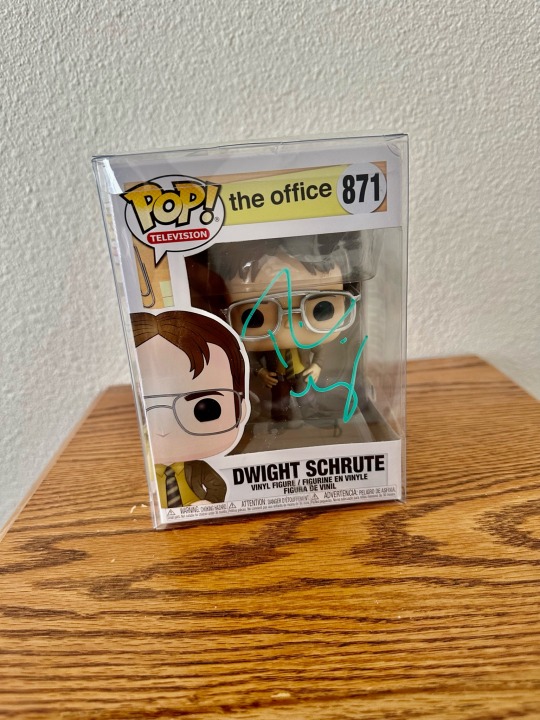


#history#nostalgia#funkocollection#funko pop#pop culture#pop video#nerd life#funkofamily#funkocommunity#funko figures#funkoaddict#funkoexclusive#vinyl#art toy#nostolgia#nostalgeek#nostalgic#anime figure#marvel#autograph#robert downey junior#stan lee#funkophotoaday#custom funko#funko soda#anime collecting#collectible#collection#figure collecting#the collecter toh
0 notes
Text
History Of Nippon China
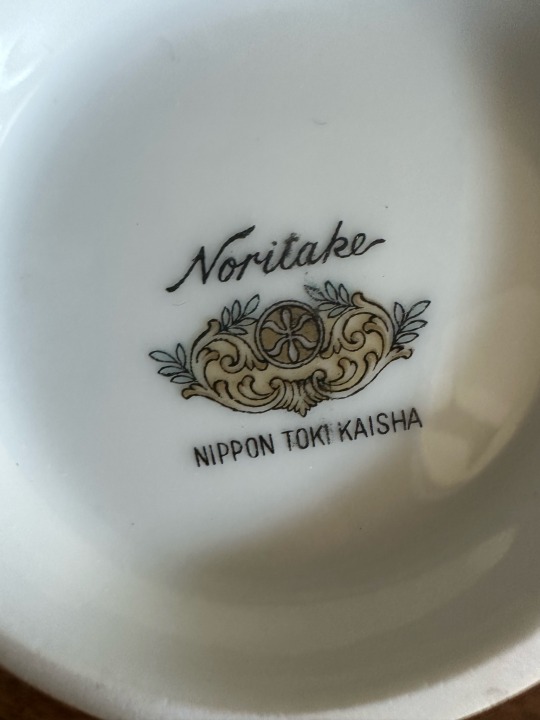
The first Nippon china pieces were decorated with traditional Japanese motifs, such as cherry blossoms and landscapes. However, as the company became more successful, they began to incorporate Western designs and styles into their products. By the 1920s, Nippon china had become known for its high-quality craftsmanship and innovative designs.
During World War II, the production of Nippon china was halted due to the war effort, and the company shifted its focus to producing military supplies. After the war, the company resumed production and began exporting its products to the United States and other countries.
In the 1950s and 1960s, Nippon china experienced a surge in popularity, and its products were highly sought after by collectors. The company continued to produce a wide range of designs, from traditional Japanese motifs to modern and abstract patterns.
Today, Nippon china is still produced under the Noritake brand, and is known for its high-quality porcelain and ceramics. The company has expanded its product line to include a wide range of tableware, including dinner plates, bowls, and serving dishes, as well as collectible figurines and other decorative items.
Overall, the history of Nippon china is a testament to the enduring popularity of fine porcelain and ceramics, and the company's commitment to quality and craftsmanship has made it a beloved brand among collectors and consumers around the world.
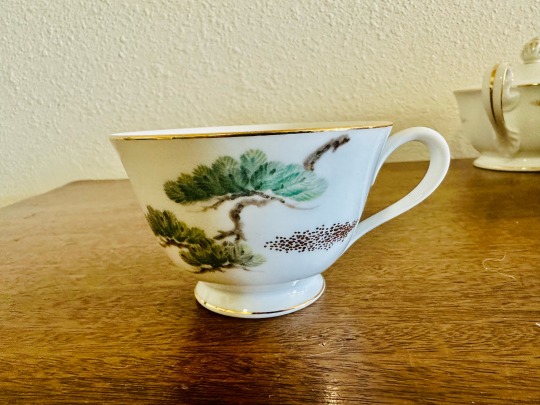
#antiques#collectables#collectible#collectibles#nippon#japan#japan culture#teacups#tea set#handcrafted#handmade#handpainted#ceramic art#ceramics#history#1920s art#vintage#vintage style#oldschool#japanese history#japanese art#made in japan#asian#asian culture#collection#tea cup#tea#tea time#antique#fine china
1 note
·
View note
Text
About Beer Steins!
Beer steins have a long and storied history dating back to the 14th century. These decorative drinking vessels were originally used to serve beer in Germany, and have since become a symbol of German culture and tradition. Today, beer steins are still a popular way to enjoy a cold brew, and are often used as decorative pieces or gifts. In this article, we'll explore the history and evolution of beer steins, from their humble beginnings to their current popularity.
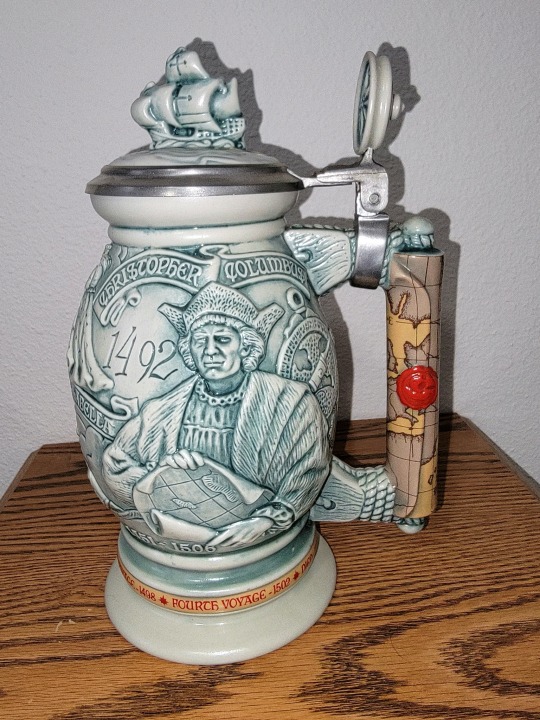
Origins of Beer Steins
The origins of beer steins can be traced back to the late Middle Ages, when beer was a staple drink in many European countries. At the time, beer was typically served in wooden or leather cups, which were prone to leaking and breaking. In response to this problem, German potters began making beer steins out of stoneware, a durable and non-porous material that was perfect for holding beer.
The first beer steins were simple vessels, with straight sides and a basic handle. They were often decorated with simple designs or the coat of arms of the local town or region. As the popularity of beer steins grew, so did the artistry of their designs. Potters began creating intricate relief designs, often depicting scenes from German folklore, history, or mythology. These designs were typically hand-carved into the clay before firing, and then painted with colorful glazes.
One of the most famous early beer steins is the "Wickingerkrug," or Viking Stein, which dates back to the 16th century. This stein features a relief design depicting a Viking ship, complete with warriors and sea monsters. It was made by the renowned German potter Bartmann, and is considered a masterpiece of the early stein-making tradition.
Evolution of Beer Steins
As the popularity of beer steins grew, so did their variety and complexity. Potters began experimenting with different shapes and sizes, as well as different materials. Some steins were made from glass, while others were made from porcelain or even silver. The designs also became more elaborate, featuring intricate relief work, hand-painted scenes, and even jewels or precious metals.
One of the most famous stein-makers of the 19th century was the German company Mettlach. Founded in 1842, Mettlach quickly became known for its high-quality steins, which featured intricate relief designs and innovative materials. One of their most famous designs is the "Grenadierkrug," or Grenadier Stein, which features a detailed relief of a Prussian grenadier, complete with his uniform and weapons. The stein is made from a special type of stoneware called "Metlach-ware," which is known for its durability and resistance to cracking.
During the 20th century, beer steins became even more popular, especially in the United States. Many American soldiers stationed in Germany during World War II brought home steins as souvenirs, and the tradition continued after the war ended. Today, beer steins are a popular collector's item, and there are countless clubs and organizations dedicated to their preservation and study.
Types of Beer Steins
Beer steins come in a wide range of styles and designs, from traditional German designs to modern and abstract patterns. Some of the most popular types of beer steins include:
- Traditional German steins: These steins are often made from stoneware and feature classic German designs, such as coats of arms, crests, and scenes from German folklore or history.
- Character steins: These steins feature relief designs of famous characters, such as Santa Claus, Mickey Mouse, or sports figures.
- Occupational steins: These steins feature designs related to specific professions or trades, such as blacksmiths, brewers, or farmers.
- Military steins: These steins often feature military motifs, such as soldiers, tanks, or airplanes, and are popular among collectors of military memorabilia.
- Novelty steins: These steins come in a wide range of designs and shapes, from animals to vehicles to pop culture references.
In addition to their design, beer steins can also vary in size and capacity. Traditional German steins typically hold around half a liter of beer, while larger steins can hold up to a liter or more.
Collecting Beer Steins
Beer stein collecting has become a popular hobby for many people around the world. Some collectors focus on acquiring specific types of steins, such as those from a particular region or time period, while others collect based on their personal interests or favorite designs.
There are many factors that can affect the value of a beer stein, including its age, rarity, and condition. Some of the most valuable steins are those made by famous makers, such as Mettlach or Reinhold Hanke, and those with intricate relief designs or historical significance.
If you're interested in starting a beer stein collection, there are many resources available online and in person. There are numerous clubs and organizations dedicated to the study and preservation of beer steins, and many collectors are happy to share their knowledge and expertise with newcomers.
Conclusion
Beer steins have a long and rich history, dating back to the Middle Ages in Germany. Over the centuries, these decorative drinking vessels have evolved in both design and function, becoming a symbol of German culture and tradition. Today, beer steins continue to be popular among beer enthusiasts and collectors around the world. Whether you're interested in the artistry of their designs, their historical significance, or simply their practical use as a beer vessel, beer steins are a fascinating and enduring part of our cultural heritage.
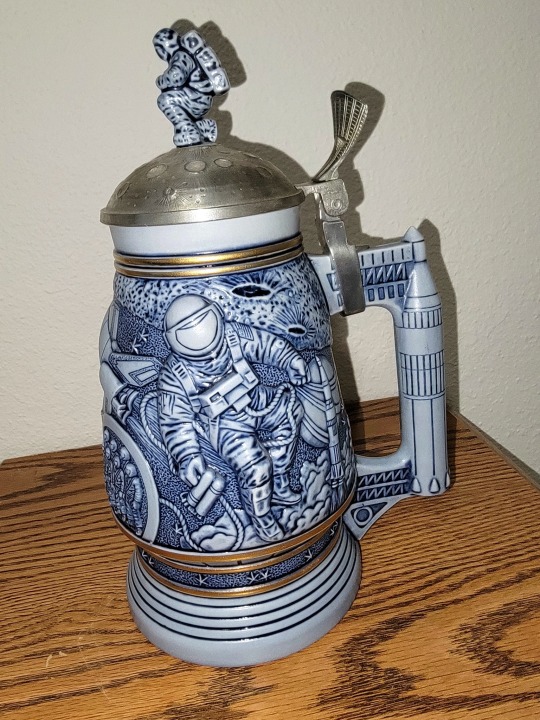
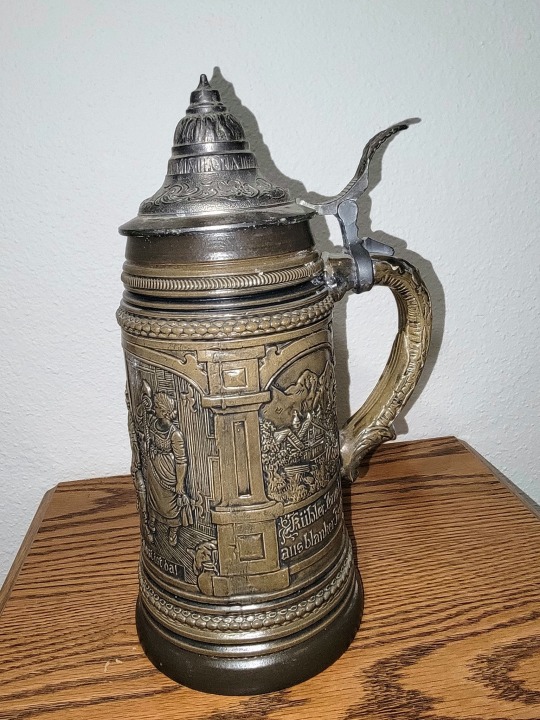
#collectible#collectables#collectibles#antiques#history#vintage#stein#beer stein#clay art#beer#80s#70s#germany#west germany#east germany#craft beer#beertime#fathersday#beerstagram#beer gut#beergeek#beerporn#ceramic mug#vintage avon#vintage style#nostalgia#nostagiacore#german culture#german cup#mugcollector
1 note
·
View note